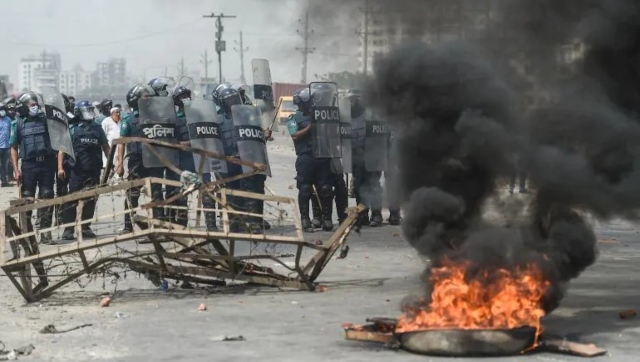On Thursday, Hindu temples in Bangladesh were vandalised by some unidentified miscreants during Durga Puja celebrations, prompting the government to deploy paramilitary force and Prime Minister Sheikh Hasina vowing “justice and swift action.”
This is just the latest instance of minorities and their religious sites coming under attack in the neighbouring countries. Let’s examine the situation of minorities in Bangladesh and Pakistan, their numbers in neighbouring countries, why they are facing persecution and how the authorities are handling it.
Why they are facing persecution
The Partition of India on religious lines had a lasting impact on intercommunal relations in the newly independent states.
As MinorityRights put it: ‘Because of the British strategies of categorisation and enumeration, notions of majority and minority became equated with dominance and disenfranchisement.’
Sure, India got independence but the turmoil was far from over because her neighbours were not at peace. A unified idea of Pakistan entailed the unification of West Pakistan (now Pakistan) and East Pakistan (now Bangladesh) but however, that was far from the reality.
From 1947 through 1970, there was widespread unrest in both Pakistan and Bangladesh primarily over the refusal of the Pakistani government to recognise Bengali as an official language of united Pakistan and their insistence on Urdu being the official language of the country. This led to a divide between Urdu and Bengali speakers, culminating in what is known as the (Bengali) Language Movement.
The persistent social, political and economic exclusion of East Pakistan galvanised the formation of a Bengali nationalist movement. At the same time, religious minorities faced an increasingly hostile environment as Pakistan enacted a series of repressive measures, including the passing 1965 of the Enemy Property Act that paved the way for the widespread expropriation of Hindu-owned land.
This culminated in the 1971 Bangladesh Liberation War when West Pakistan military was deployed to East Pakistan, which resulted in the deaths of an unknown number of civilians – estimated by some sources as between 3,00,000 and 5,00,000, though the official government estimate is 3 million – in a targeted campaign that included widespread sexual violence.
That ended with the Pakistan military’s surrender on 16 December 1971 to the Indian military.
Bangladesh
Hindus account for almost 8.5 percent of the population in Bangladesh, while Buddhists and Christians make for 0.6 percent and 0.3 percent of the population, respectively, the religious minority statistics as per a minority rights report, based on the 2011 Census, shows.
Bangladesh’s trajectory in the decades since independence has seen a shrinking of its religious diversity, reflected in the relative decline of religious minorities from 23.1 percent of the population in 1971 to 9.6 percent today – a contraction largely due to the mass migration of its Hindu population.
Bangladesh ranked 56th in 2020’s Peoples under Threat list with the communities at risk being Hindus, Ahmadiyya, other religious minorities and Chittagong hill tribes.
Atrocities against minorities in Bangladesh
2021
Any sort of opinions, disgruntlement from minorities invite hardline actions. To this tune, this year in March, a young Hindu man’s alleged Facebook post criticising Hefazat-e-Islam’s leader Mamunul Haque’s speech, led to hundreds of supporters of a hardline Islamist group in Bangladesh attacking and vandalising 70 to 80 houses of Hindus in the country’s northeastern Sylhet division.
2020
The Islamic State claimed an October grenade attack on a Shia shrine Dhaka , which killed one and injured around 80 people, though their claim was dismissed by the government.
In October 2020, media outlets reported that a crowd of several hundred persons beat to death a Muslim visiting a mosque after a rumor spread that he desecrated a Quran in Lalmonirhat District, Rangpur Division near the country’s northern border. The man’s body was then set on fire.
Protestant Churchgoers Jogendranath Sarker and his five-member family had to leave Kushtia district in northwestern Bangladesh and moved to Kolkata in February 2020 to escape the tyranny of influential Muslims who wanted him to hand over his 1.66-acre plot of land to them. His house was on the receiving end of three arson attacks and he received many eviction threats.
Ahmadis, considered non-Muslims by the Sunnis (majority in Bangladesh), are also far from safe. The “ 2020 Report on International Religious Freedom: Bangladesh ” report mentions an incident that took place in Brahmanbaria in July when local residents exhumed the body of an Ahmadi Muslim infant buried in a government graveyard and later dumped the body at the side of the road . The protesters considered her family to be “infidels”; the body was later buried in a government cemetery.
A Muslim crowd burned, looted, and vandalized Hindu family homes in Comilla in November last year. Rumors that local Hindu residents supported the publication in the French magazine Charlie Hebdo of caricatures of the Prophet Muhammad, spurred the attack.
2016
As per a BBC report, Islamic State (IS) “caliphate soldiers” in 2020 claimed responsibility for the 2016 murder of a Hindu priest, Jogeswar Roy. He was attacked by two assailants armed with pistols and cleavers at his home in the temple.
On 12 March, 2020, a Bangladesh Speedy Trial Tribunal convicted and sentenced to death four Muslim defendants of the group Jamaatul Mujahidin Bangladesh (JMB), a violent extremist group accused of the 2016 killing of the priest.
2015
In 2015, Avijit Roy , based in the US and of Bangladeshi origin, was attacked with machetes as he left a book fair in Dhaka in February 2015. Roy, an atheist, had supposedly angered the hardliners with his writings on religion.
2009-2010
According to the Bangladesh Buddhist-Hindu-Christian Unity Council (BHBCOP), during the period from March 2009 to May 2010, there were at least 150 incidents of repression including land seizures, arson, rape, and at least three killings.
One of the core reasons behind the attacks
Attacks against Hindu temples and Hindu homes have been occurring in bulk over many years. Many members of the Hindu community were alienated from their land by the Vested Property Act.
Even though the Act was repealed in 2000, its implementation is in limbo. Hindu places of worship have been ransacked, villages destroyed and scores of Hindu women are reported to have been raped and injured.
Pakistan
Religious minorities in Pakistan include Christians (1.59 percent, 1998 Census), Ahmadis (0.22 percent, 1998 Census), Hindus (1.6 percent, 1998 Census), Shi’as, Isma’ilis, Bohras, Parsis and Sikhs and the main religions followed include Islam, Hinduism, Christianity, Buddhism and Ahmadiyya.
Hindus in Pakistan account for approximately less than 2.5 million people according to the 1998 Census. The Pakistan Hindu Council, however, has estimated that the total Hindu population now exceeds 7 million.
Pakistani Hindus face forced conversions, rape, child marriage, and suppression. The New York Times reported that lower-caste Pakistani Hindus are often the victims of bonded labor. It was outlawed in 1992, but the practice is still prevalent.
It also mentioned how poverty, hopelessness and close to no power precipitates into them turning to Islamic conversion for survival.
Dalits comprise 85 percent of the total Hindus population in Pakistan and are the most vulnerable.
2021
UCA news reported in January this year that as per a Washington-based International Christian Concern, 24 Christians are imprisoned in Pakistan on blasphemy charges and face 21 different cases at various stages.
Pakistan’s Khyber Pakhtunkhwa government, in July this year, said that criminal cases against 350 people accused of burning down the temple will be withdrawn, claiming that the minority Hindu community has pardoned them.
This year, on 3 Januray, 11 Shia Hazara miners were killed in a brutal attack claimed by Islamic State gunmen in Balochistan province.
2020
Pakistani Christians and Hindus face many challenges even though they have the largest populations in terms of percentage. Christians and Hindus are also vulnerable to persecution under the blasphemy laws (which drew the condemnation of UN rights chief Michelle Bachelet in 2020) although there aren’t other specific legal provisions that target Christians or Hindus, as is the case with Ahmadis.
On 9 May 2020, a Christian church in Pakistan’s Punjab province was desecrated in a land grab crime. On 11 May, 21 Hindu homes were set on fire in villages in the country’s Sindh province. In one village, a Hindu woman was sexually assaulted and her family attacked, shows a European Parliament report .
On 30 December, hundreds of villagers led by local clerics stormed the Krishna Dwara temple in Karak district of Khyber Pakhtunkhwa province and set it on fire. The mob also attacked an under-construction house allegedly occupied by a Hindu man. According to reports, clerics made provocative speeches against the alleged expansion of the Hindu temple, leading to the attack.
However, Pakistan’s Supreme Court ordered the Khyber-Pakhtunkhwa government to immediately start rebuilding a century-old Hindu temple that was vandalised by a mob in the province, and submit a timeline for its completion.
2019
Violent protesters attacked a school in 2019 after a blasphemy case was filed against Nautan Lal , principal of the Sindh Public School. Blasphemy, which is punishable by death in Pakistan, is a sensitive topic in the country, where 97 percent of its 180 million inhabitants are Muslim.
2017-18
Journalists and bloggers continue to sustain threats, attacks and abductions, and the blasphemy law serves to coerce people into silence the Human Rights Commission said in 2017-18. The people’s right to socio-cultural activities is curtailed by intolerance and extremism, and authorities are lenient for fear of a political backlash, it said.
In 2017, a teenage Hindu girl was abducted from a village in Thar and forced to convert to Islam and reportedly made to enter a marriage, her family and relatives claimed. The family of the 14-year-old girl told reporters that three armed men barged into their home and held the family hostage.
2012
On 4 December 2012, six-year-old Vijanti Meghwar was brutally raped in Ghulam Nabi Shah village in the Sindh province of Pakistan. Vijanti belongs to the Meghwar community of the country’s minority Hindu population.
2010
In July 2010 about 60 Hindus were forced to abandon their homes and hide in a cattle pen at Memon Goth in Karachi after influential tribesmen of the area objected to a boy drinking water from a cooler near a mosque.
Core reasons behind the attacks in Pakistan
The country’s stringent blasphemy laws inspire persecution.
Although the official position in relation to the existence of religious, linguistic and ethnic minorities is shrouded in controversy, Pakistan’s minorities can essentially be categorised as ‘ethnic and linguistic’ and ‘religious’.
As per a minority rights report, a census was conducted in Pakistan in 2017. Though the full results are yet to be released it is expected that the findings will show a decline in the proportion of religious minorities in the country, given the widespread persecution – and resulting emigration – many communities have faced in the last two decades.
In conclusion, minorities in these two countries are increasingly under threat of losing their lives, property and religious identity.
With inputs from agencies


)




)
)
)
)
)
)
)
)